Nothing beats the satisfaction of creating the perfect BBQ meat platter that’ll have your guests talking for weeks. We’ve all been there – staring at an empty platter wondering how to transform it into a show-stopping centerpiece that screams “backyard barbecue perfection.” The secret isn’t just about throwing meat on a board and calling it a day.
Creating an impressive BBQ meat platter is an art form that combines strategic planning with mouth-watering presentation. We’re talking about perfectly smoked brisket paired with juicy pulled pork, tender ribs that fall off the bone, and grilled chicken that’s crispy on the outside and succulent on the inside. The magic happens when you know exactly how to arrange these proteins alongside the right sides and sauces.
Whether you’re hosting a casual backyard gathering or planning an elaborate outdoor feast, we’ve got the insider tips that’ll transform your meat platter from ordinary to extraordinary. Let’s jump into the game-changing ideas that’ll make you the BBQ hero of every gathering.
Classic BBQ Meat Combinations for Your Platter
Building your BBQ meat platter around proven protein pairings ensures every guest finds their perfect bite. These time-tested combinations create balance in flavors, textures, and cooking methods that define exceptional barbecue platters.
Brisket and Pulled Pork Duo
Brisket and pulled pork form the ultimate BBQ power couple that satisfies both texture lovers and flavor enthusiasts. We recommend allocating 6-8 ounces of brisket per person alongside 4-5 ounces of pulled pork to create the perfect serving ratio.
Smoky brisket brings deep, rich flavors with its signature bark and tender interior that melts in your mouth. Pulled pork adds sweetness and moisture that complements the brisket’s intensity perfectly. Together, these proteins offer guests two distinct eating experiences on one platter.
Position your brisket slices against the grain at a 45-degree angle for optimal presentation and tenderness. Pile the pulled pork in small mounds beside the brisket to create visual contrast and easy serving access.
Ribs and Sausage Links Pairing
Ribs and sausage links create an irresistible combination that showcases both slow-cooked perfection and quick-grilled satisfaction. We suggest featuring 3-4 rib bones per person paired with 2-3 sausage links to maintain proper portion balance.
Baby back ribs deliver fall-off-the-bone tenderness with caramelized edges that provide textural variety. Smoked sausage links offer immediate gratification with their crispy exteriors and juicy centers. This pairing works exceptionally well because the ribs require hands-on eating while sausages provide easy grab-and-go options.
Arrange your ribs in overlapping rows to display the meat’s natural curve and color. Place sausage links perpendicular to the ribs to create geometric visual interest across your platter.
Chicken and Beef Mix
Chicken and beef combinations satisfy diverse palates while offering both white and red meat options on your BBQ platter. We recommend including 2-3 chicken pieces per person alongside 4-5 ounces of beef cuts like tri-tip or sirloin steaks.
Grilled chicken thighs provide juicy, flavorful bites with crispy skin that adds textural excitement. Beef cuts contribute robust, savory flavors with the perfect char that BBQ enthusiasts crave. This mix accommodates guests who prefer lighter proteins without sacrificing the hearty satisfaction that beef delivers.
Feature your chicken pieces skin-side up to showcase the golden-brown color and crispy texture. Slice beef cuts against the grain and fan them out to display the perfect pink interior and caramelized exterior.
Regional BBQ Styles to Feature on Your Meat Platter
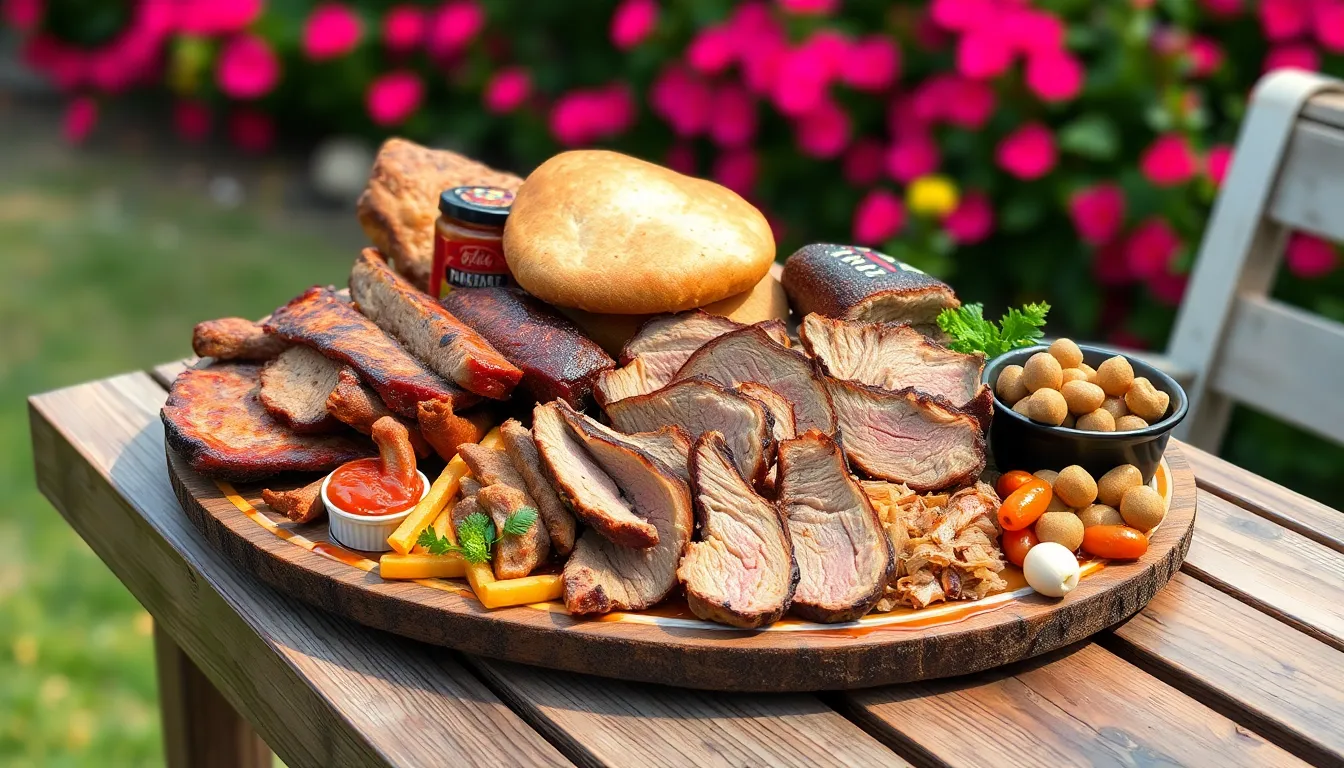
Regional BBQ traditions offer distinct flavor profiles that’ll transform your meat platter into an authentic culinary experience. Each style brings unique cooking methods and signature seasonings that showcase America’s diverse barbecue heritage.
Texas-Style Beef-Forward Platter
Texas BBQ centers on beef brisket, the state’s barbecue “pride and joy” that reflects German and Czech butchering traditions. We recommend featuring slow-smoked brisket as your centerpiece, seasoned with the classic Dalmatian rub of coarse salt and black pepper to highlight the meat’s natural flavor. Smoking the brisket for 12-18 hours at temperatures between 225-265°F creates that perfect balance between the fatty “point” cut and lean “flat” portions.
Complement your brisket with St. Louis-style ribs, smoked chicken, and hot sausages to create a complete Texas-style spread. This beef-forward approach delivers bold, smoky flavors that satisfy hearty appetites. Position the brisket slices prominently on your platter, showcasing both the bark and the pink smoke ring that defines authentic Texas barbecue.
Carolina Pulled Pork Specialties
Carolina BBQ represents one of America’s oldest barbecue styles, focusing primarily on slow-roasted whole hog or pork shoulder preparations. Eastern North Carolina features whole hog barbecue cooked for 12-24 hours, using all parts of the hog balanced with vinegar-based mop sauces for moisture. Western North Carolina’s Lexington-style emphasizes smoked pork shoulder dressed with a tangy ketchup-vinegar-pepper sauce combination.
South Carolina earns recognition as the “Mustard Belt” for its signature mustard-based “Carolina Gold” sauce that creates unique flavor profiles. We suggest offering pulled pork with multiple sauce options to represent these diverse regional preferences. Arrange the pulled pork in generous portions, allowing guests to experience the authentic tangy and vinegar-forward flavors that define Carolina barbecue traditions.
Kansas City Mixed Meat Selection
Kansas City BBQ showcases variety through a “smorgasbord” of slow-smoked meats including pork ribs, beef brisket, burnt ends, sausage, and chicken. The meats receive sweet spice rub treatments and finish with thick, sweet, tomato-based sauces that balance sweet, smoky, and tangy elements. This style offers both dry-rubbed and sauced options to satisfy different preferences.
Create your Kansas City platter by featuring multiple meat types that demonstrate this region’s commitment to diversity. Burnt ends deserve special attention as Kansas City’s signature contribution to barbecue culture. We recommend arranging the various meats in distinct sections while providing the characteristic sticky-sweet sauce on the side, allowing guests to customize their barbecue experience with authentic Kansas City flavors.
Creative Meat Cutting and Presentation Techniques

Transform your BBQ spread from ordinary to extraordinary with strategic cutting and presentation methods. Master these techniques to create visually stunning platters that’ll make your guests’ mouths water before they even take their first bite.
Slicing Methods for Different Cuts
Uniform slices maximize tenderness when you cut brisket or pork shoulder against the grain. Thinner slices work perfectly for delicate cuts like brisket, while thicker portions showcase the hearty texture of ribs and sausages.
Varied cuts provide guests with diverse texture experiences throughout your platter. Mix whole pieces alongside sliced sections and shredded meats to create visual variety that keeps everyone interested.
Against the grain cutting breaks down tough muscle fibers in tougher cuts like flank steak or brisket. Position your knife perpendicular to the visible muscle lines for maximum tenderness in every bite.
Consistent thickness ensures even cooking and professional presentation across your entire spread. Aim for quarter inch slices for most cuts, adjusting slightly based on the exact meat’s texture and density.
Arranging Meats by Color and Texture
Color coordination creates vibrant displays when you arrange meats by gradient or contrast. Place darker smoked brisket beside reddish sausages or golden grilled chicken to make each protein pop visually.
Texture grouping highlights contrasts that make your platter both pleasing to look at and easy to navigate. Group crispy items together or alternate them with juicy cuts to showcase the variety in your BBQ selection.
Height variation adds dimension to your presentation when you stack sliced meats or use food pedestals. Elevate certain sections to create visual interest and guide your guests’ eyes across the entire platter.
Garnish placement enhances visual harmony with fresh herbs like cilantro, parsley, or basil scattered strategically. Add citrus wedges or microgreens to provide bursts of color that complement your meat selection.
Temperature Zones for Hot and Cold Items
Hot zones maintain ideal eating temperature for freshly grilled or smoked meats in designated platter sections. Use heated serving trays to keep proteins at their optimal serving temperature throughout your event.
Cold zones provide refreshing contrast with complementary items like pickles, slaws, or chilled sauces. Separate these items on chilled boards to prevent temperature cross contamination while balancing flavors.
Clear separation prevents temperature mixing while improving presentation aesthetics across your entire spread. Designate exact areas for hot and cold components to maintain food safety and visual appeal.
Serving vessel selection supports temperature control when you choose appropriate platters like rustic wooden boards for hot items or chilled porcelain for cold accompaniments. Match your serving ware to complement each section’s temperature requirements.
Essential Side Dishes to Complement Your BBQ Meat Platter
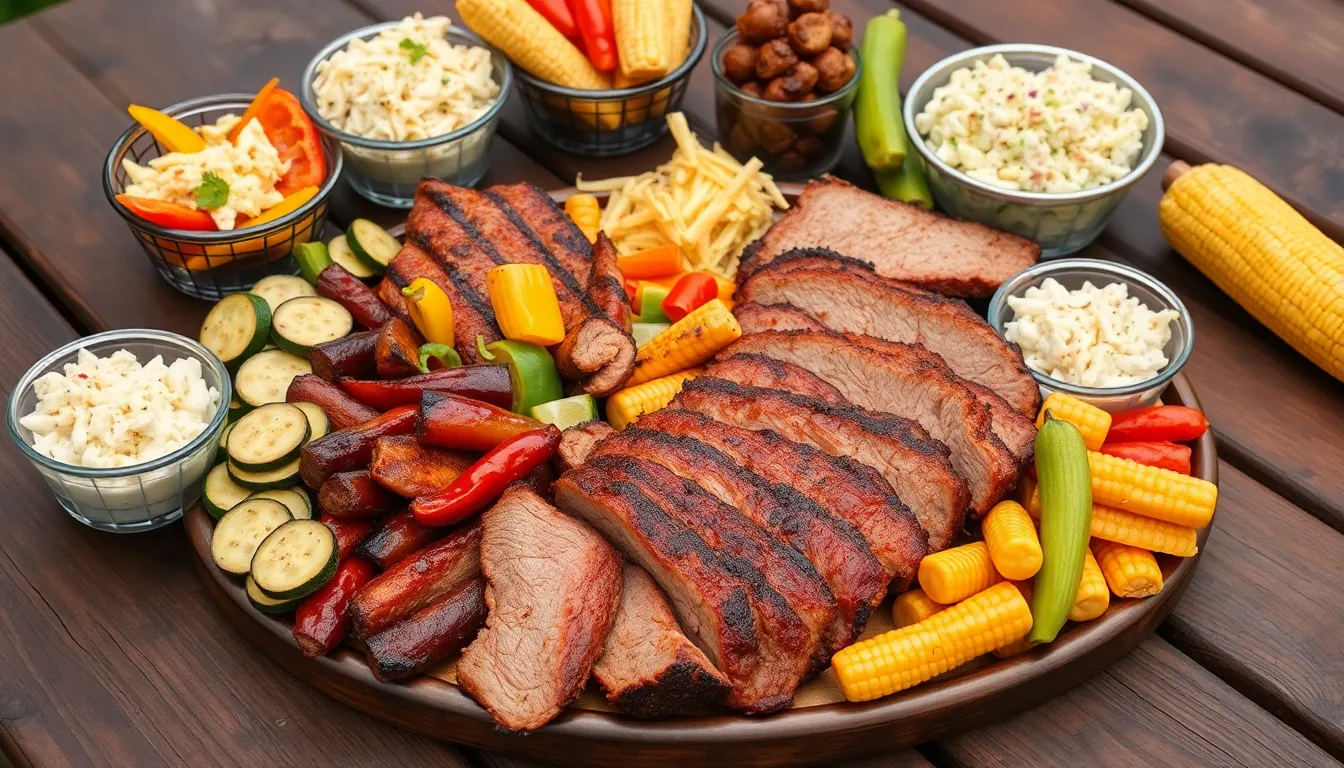
Now that we’ve perfected our meat selection and presentation, let’s turn our attention to the supporting cast that transforms a good BBQ platter into an unforgettable feast. Strategic side dish selection balances the rich, smoky flavors of our grilled proteins while adding texture and visual appeal to the spread.
Traditional Coleslaw and Potato Salad
Coleslaw delivers the perfect tangy contrast our BBQ meat platter needs to cut through rich, fatty proteins. We recommend preparing this classic with shredded cabbage and a light vinegar or creamy dressing that provides crisp texture against tender meats. Traditional coleslaw recipes work beautifully, but consider adding apple slices or carrots for extra crunch and sweetness.
Potato salad serves as the hearty foundation that anchors our side dish lineup with its creamy, satisfying qualities. We typically prepare ours with boiled red or Yukon potatoes, mayonnaise or mustard-based dressing, and fresh herbs like dill or chives. Classic potato salad pairs exceptionally well with smoky brisket and pulled pork, absorbing those delicious meat juices while providing cooling relief from spicy BBQ sauces.
Grilled Vegetables and Corn
Grilled vegetables bring fresh, smoky elements that enhance rather than compete with our main proteins. We love grilling zucchini, asparagus, bell peppers, and red onions alongside our meats, creating colorful variety while maximizing grill space efficiency. These vegetables add essential nutrients and vibrant colors that make our platter Instagram-worthy.
Corn on the cob offers sweet, buttery perfection that complements every BBQ meat we’ve discussed. We prefer grilling or roasting corn directly over coals for that signature char, then serving it simply with butter or elevating it with herb butter, cotija cheese, or chili powder. Sweet corn kernels also work beautifully in our cowboy caviar or fresh corn salads.
Bread and Pickle Accompaniments
Bread serves the practical purpose of soaking up those precious meat juices and BBQ sauces we’ve worked so hard to perfect. We recommend offering cornbread, dinner rolls, or sliced baguette that guests can use to create impromptu sandwiches. Cornbread salad presents an interesting twist, layering crumbled cornbread with beans, corn, bacon, and cheese for a substantial side dish.
Pickles provide essential acidic contrast that cuts through fatty meats and refreshes the palate between bites. We always include classic dill pickles or pickled vegetables like cucumbers, onions, and jalapeños on our BBQ spread. These tangy accompaniments help cleanse the palate and prepare taste buds for the next flavorful bite of our carefully crafted meat selections.
Sauce and Seasoning Pairings for Different Meats
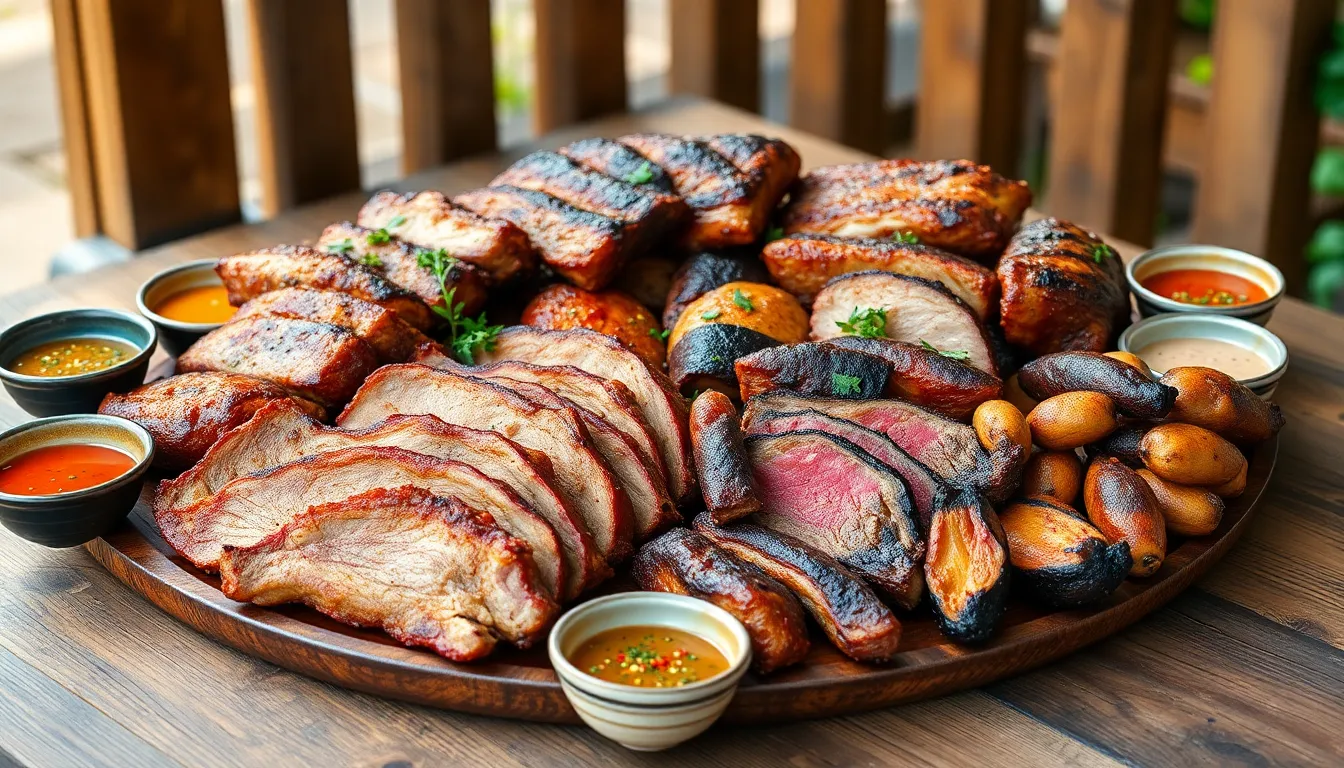
Mastering the art of sauce and seasoning combinations transforms ordinary BBQ meat platters into unforgettable culinary experiences. Our carefully selected pairings enhance each protein’s natural flavors while creating a harmonious balance across your entire spread.
Dry Rub Applications for Beef and Pork
Beef ribs and brisket demand bold, smoky dry rubs that complement their rich, robust flavors. We recommend combining salt, black pepper, garlic powder, onion powder, and paprika as your foundation. Adding coffee grounds or cocoa powder creates complex depth that elevates your beef’s natural taste profile.
Trim excess fat before applying your dry rub generously to ensure proper penetration and bark formation. Press the seasoning mixture firmly into the meat’s surface, creating an even coating that will develop into that coveted crusty exterior during the smoking process.
Pork shoulders and ribs benefit from sweet and spicy combinations featuring brown sugar, chili powder, cumin, and mustard powder. Brown sugar caramelizes during cooking, creating a beautiful glaze while the spices add warmth and complexity. Apply these rubs at least 2 hours before cooking, allowing the flavors to penetrate the meat fibers.
Smoke your seasoned meats at 275°F for optimal results, maintaining consistent temperature throughout the cooking process. This low and slow approach allows the dry rub to form a perfect bark while keeping the interior tender and juicy.
Tangy Sauces for Chicken and Turkey
Mustard honey sauces brighten poultry’s mild flavors with their perfect balance of tang and sweetness. We combine yellow mustard, honey, apple cider vinegar, and a touch of garlic powder to create this versatile sauce that complements both grilled and smoked chicken.
Citrus based BBQ sauces add fresh brightness to turkey and chicken dishes. Mix orange juice, lime zest, tomato paste, and brown sugar for a sauce that cuts through rich, smoky flavors while improving the meat’s natural taste.
Vinegar based Carolina sauces work exceptionally well with pulled pork but also enhance chicken wings and thighs. Eastern Carolina’s vinegar and pepper combination provides sharp acidity that balances fatty cuts, while Western Carolina’s tomato addition offers more body and sweetness.
Yogurt based chutneys create unique flavor profiles by combining lime juice, cilantro, and mango chutney with Greek yogurt. This cooling sauce provides a refreshing contrast to spicy dry rubs and works particularly well with grilled chicken breast.
Sweet and Spicy Options for Variety
Honey chipotle sauces deliver perfect heat and sweetness balance that works across multiple meat types. We blend chipotle peppers in adobo sauce with honey, apple cider vinegar, and tomato paste for a versatile option that complements beef, pork, and chicken equally well.
Peach BBQ sauce offers fruity sweetness with subtle heat that pairs beautifully with pork ribs and chicken thighs. Combine fresh peach puree, brown sugar, bourbon, and a pinch of cayenne pepper for this crowd pleasing option.
Brown sugar and cayenne dry rubs create caramelized crusts with mild heat that appeals to most palates. This combination works particularly well on pork shoulders and beef short ribs, developing a glossy exterior during the cooking process.
Serve multiple sauce options in separate bowls to allow guests to customize their plates according to personal preferences. We recommend offering at least three varieties: one tangy, one sweet, and one spicy option to accommodate different taste preferences.
Portion Planning and Meat Selection Guidelines

With your BBQ meat combinations and presentation techniques perfected, we’ll now focus on the strategic planning that ensures every guest leaves satisfied while keeping your budget intact.
Calculating Quantities per Guest
Planning portions accurately prevents both shortages and excessive waste at your BBQ gathering. We recommend allocating 1/2 to 3/4 pounds of meat per person, which translates to 8 to 12 ounces per guest and accounts for hearty appetites and multiple servings.
Conservative eaters typically consume around 6 ounces (0.375 pounds) per guest, making this amount suitable for mixed platters or events with substantial side dishes. Larger gatherings with avid meat lovers require planning toward the higher end of our recommended range.
Event size directly impacts portion calculations, as bigger crowds often include more diverse appetites. Consider your guest list carefully when finalizing quantities, factoring in whether you’re hosting casual neighbors or serious BBQ enthusiasts.
Choosing Quality Cuts Within Budget
Selecting the right cuts balances exceptional flavor with smart spending decisions. Popular BBQ platter options include pork ribs, beef brisket, pulled pork, chicken wings, chicken thighs, sausages, steaks, and burgers, each offering different price points and cooking requirements.
Premium cuts like baby back ribs and brisket deliver outstanding flavor but command higher prices than budget friendly alternatives such as chicken thighs or sausages. Buying whole chickens or larger brisket portions allows you to control portioning while reducing per pound costs.
Consider your grill or smoker capacity when selecting cuts, as different meats require varying cooking times and space allocation. Planning efficiently means choosing cuts that complement your equipment’s capabilities and your timeline.
Balancing Lean and Fatty Meat Options
Creating variety through fat content ensures every guest finds their preferred flavor profile. Chicken breasts and thighs provide leaner protein choices, while ribs, brisket, and pulled pork offer rich, fatty options with intense marbling and deep flavors.
Mixing textures and fat levels creates more interesting eating experiences, such as pairing smoky ribs with crisp coleslaw and grilled vegetables for contrast. This approach prevents palate fatigue while showcasing your range as a pitmaster.
Nutritional balance benefits from strategic pairings, as fatty cuts work exceptionally well alongside tangy or acidic sides that cut through richness. Complement rich brisket with vinegar based slaws or serve pulled pork with pickled vegetables to enhance both taste and digestion.
Timing and Temperature Management for Multiple Meats
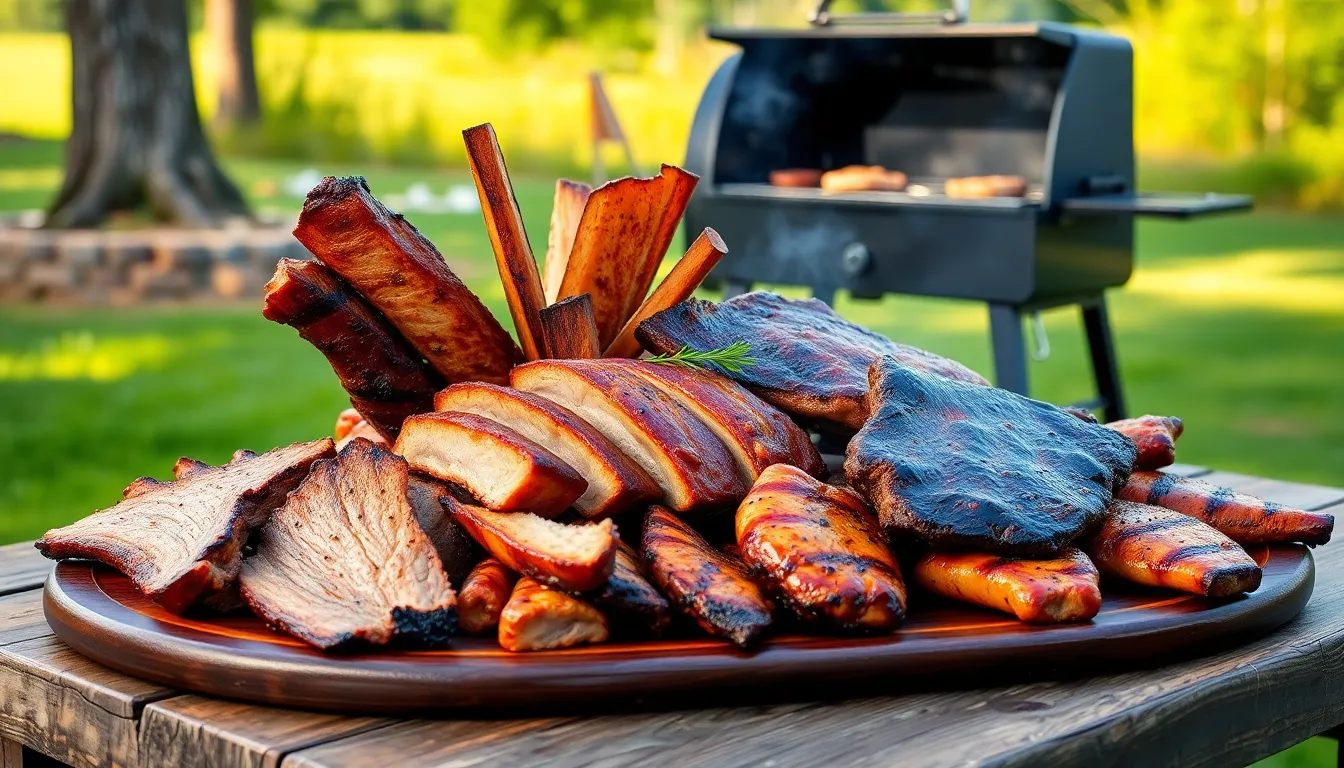
Mastering temperature control and timing transforms your BBQ meat platter from good to exceptional. We’ll guide you through the precise coordination needed to serve multiple perfectly cooked meats simultaneously.
Smoking Schedule Coordination
Starting with the longest cooking meats sets the foundation for your entire BBQ timeline. We recommend beginning with brisket and pork shoulder at your smoker temperature between 225°F to 250°F, as these cuts require 12 to 16 hours of low and slow cooking.
Planning your meat additions based on cooking times ensures everything finishes together. Add ribs to your smoker about 5 to 6 hours before serving time, while chicken and sausages need only 1 to 3 hours depending on size and desired doneness.
Monitoring internal temperatures with a digital core temperature meter eliminates guesswork and prevents overcooking. We suggest checking temperatures every hour during the final cooking stages to track progress accurately.
Adjusting your smoker temperature slightly can help coordinate timing when meats are cooking faster or slower than expected. Increasing temperature to 275°F can speed up cooking by about 25%, while dropping to 225°F extends cooking time when you need more flexibility.
Resting and Holding Techniques
Resting meats after cooking allows juices to redistribute throughout the muscle fibers, creating more tender and flavorful results. We recommend resting larger cuts like brisket and pork shoulder for 30 to 45 minutes, while smaller items like chicken and ribs need 10 to 20 minutes.
Wrapping rested meats in foil or butcher paper helps retain heat while preventing moisture loss during the holding period. This technique keeps your meats at safe serving temperatures above 140°F for up to 2 hours without compromising quality.
Creating a warming station using coolers lined with towels provides an excellent holding environment for finished meats. We’ve found that properly wrapped meats can stay warm and moist in insulated coolers for 3 to 4 hours, giving you flexibility in your serving schedule.
Slicing meats just before serving preserves maximum moisture and prevents the cut surfaces from drying out during extended holding periods.
Food Safety Temperature Guidelines
| Meat Type | Minimum Safe Temperature | Recommended Internal Temperature |
|---|---|---|
| Ground meats (burgers, sausages) | 160°F (71°C) | 160°F (71°C) |
| Beef, lamb, veal (whole cuts) | 145°F (63°C) | 125-130°F for rare, 145°F+ for medium |
| Pork shoulder/butt | 145°F (63°C) | 195-205°F for pulled pork |
| Chicken/turkey | 165°F (74°C) | 165°F (74°C) |
| Brisket | 145°F (63°C) | 195-205°F for slicing |
Using a reliable meat thermometer in the thickest part of each cut ensures accurate temperature readings and prevents foodborne illness. We always check multiple spots on larger cuts like brisket and pork shoulder to confirm even cooking throughout.
Allowing whole cuts of beef, lamb, and veal to rest for 3 minutes after reaching 145°F helps eliminate harmful bacteria while maintaining desired doneness levels. This rest period is crucial for food safety even when serving medium rare cuts.
Keeping cooked meats at temperatures above 140°F prevents bacterial growth during serving periods, especially important when your BBQ platter will be displayed for extended periods during parties or events.
Garnishing and Final Touches for Presentation
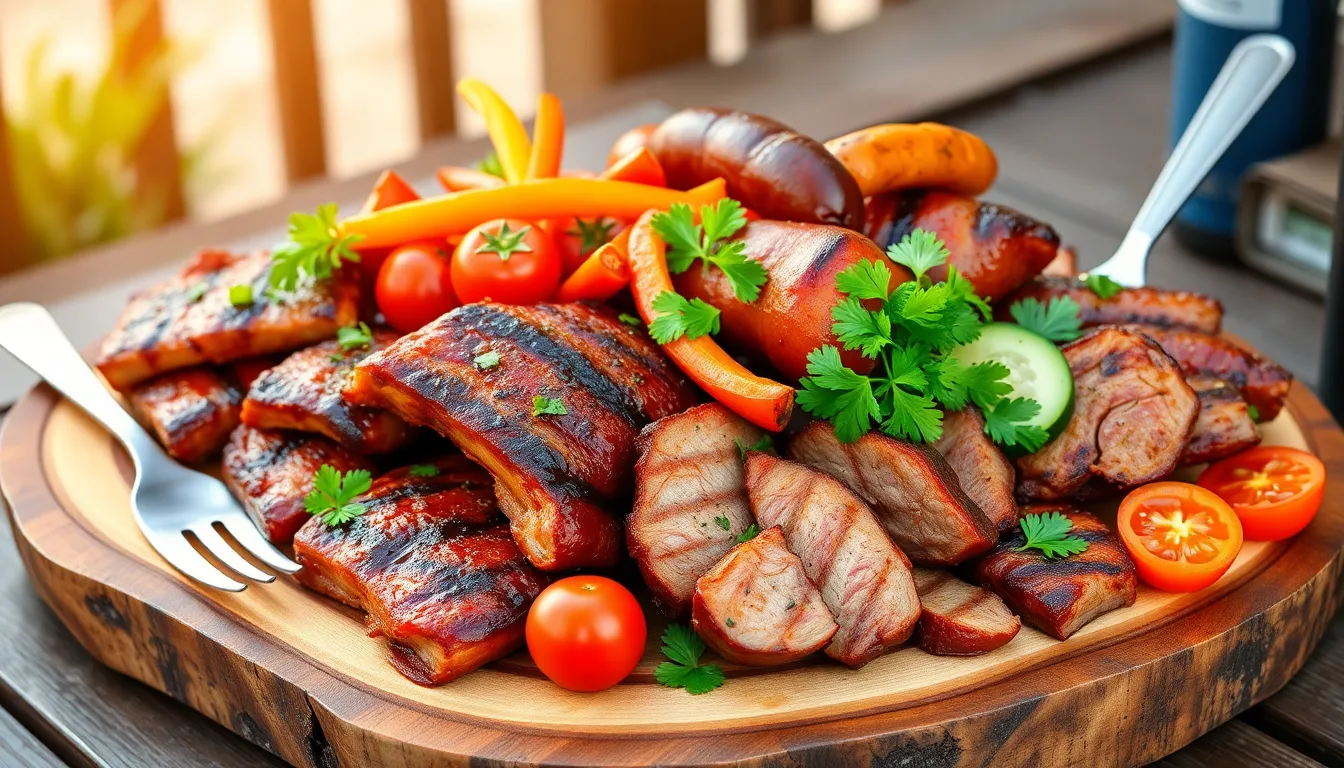
We’ll transform your BBQ meat platter from delicious to spectacular with strategic garnishing and final presentation touches that create visual impact while complementing the flavors.
Fresh Herb Arrangements
Fresh herbs provide an instant burst of color and aroma that elevates any BBQ meat platter. We recommend using cilantro, parsley, basil, or rosemary to create vibrant green accents that complement the rich flavors of smoked and grilled meats. These herbs don’t just look beautiful—they bring fresh aromas that enhance the overall sensory experience.
Arrange small bunches or individual sprigs strategically around the meat to create natural borders and visual breaks. Position herbs at corners of the platter or use them to separate different meat varieties. This technique guides the eye across the display while adding organic texture that contrasts beautifully with the robust appearance of BBQ meats.
Colorful Vegetable Accents
Vegetables add essential color contrast and freshness that balances the richness of BBQ meats. We suggest incorporating cherry tomatoes, bell pepper strips, cucumber slices, or carrot sticks to create visual interest and provide palate cleansing elements. These colorful additions prevent the platter from looking monotonous while offering guests lighter options.
Place vegetables in clusters or spiral patterns around the meat rather than scattering them randomly. Group similar colors together—red cherry tomatoes with red bell peppers, or green cucumbers with green herbs—to create color blocks that draw attention. This organized approach creates visual hierarchy while maintaining the meat as the star of the presentation.
Serving Utensil Placement
Thoughtful utensil placement completes the professional presentation while ensuring practical functionality. We recommend selecting attractive serving tools that complement your platter style—rustic wooden boards pair perfectly with classic metal tongs or vintage forks, while elegant porcelain plates invite sleek silverware or modern stainless steel implements.
Position utensils where they’re easily accessible without cluttering the meat display or disrupting the visual flow. Place larger serving forks near whole cuts like brisket or pork shoulder, while smaller tongs work well beside sliced items or sausages. This strategic placement ensures guests can serve themselves efficiently while maintaining the platter’s aesthetic appeal throughout the meal.
Conclusion
We’ve covered everything you need to create spectacular BBQ meat platters that’ll have your guests raving long after the last bite. From mastering regional styles to perfecting your presentation techniques these strategies will transform your backyard gatherings into memorable culinary experiences.
Remember that successful BBQ platter creation comes down to three key elements: quality meat selection proper timing and thoughtful presentation. When you combine these fundamentals with the right sides and sauces you’ll create platters that satisfy every palate at your table.
Now it’s time to fire up that grill and put these ideas into action. Your next BBQ event is the perfect opportunity to showcase your newfound expertise and become the pitmaster your friends and family will always remember.
Frequently Asked Questions
What meats should I include in my BBQ platter?
For a well-rounded BBQ platter, include a variety of proteins: slow-smoked brisket, pulled pork, tender ribs, and grilled chicken. This combination offers different textures and flavors while catering to diverse preferences. Consider adding sausage links for extra variety and to create an impressive spread that satisfies all guests.
How much meat should I plan per person?
Allocate 1/2 to 3/4 pounds of meat per person, depending on your guests’ appetites and the size of your event. This amount ensures everyone gets plenty while accounting for different eating preferences. Adjust portions based on whether you’re serving multiple sides and the overall appetite of your crowd.
What are the best side dishes to serve with BBQ meat?
Essential BBQ sides include tangy coleslaw, creamy potato salad, grilled vegetables, and corn on the cob. Add cornbread or dinner rolls for soaking up sauces, and include pickles as a palate cleanser. These sides provide flavor contrast and help balance the richness of the meats.
How do I properly slice BBQ meats for presentation?
Always cut against the grain for maximum tenderness, especially with brisket and pulled pork. Use sharp knives and maintain uniform thickness for consistent presentation. Arrange sliced meats by color and texture, creating height variations on your platter for visual appeal and professional-looking results.
What sauces should I offer with my BBQ platter?
Provide multiple sauce options to accommodate different tastes: tangy vinegar-based sauces for pork, bold dry rubs for beef, and sweet options like honey chipotle or peach BBQ sauce. Include mustard-based and citrus sauces for lighter meats like chicken, ensuring every guest finds their perfect flavor match.
How do I keep meats at safe temperatures during serving?
Maintain hot meats at 140°F or above using warming trays or slow cookers. Keep cold items like coleslaw below 40°F with ice baths or refrigerated serving dishes. Use separate serving utensils for each meat to prevent cross-contamination and follow the 2-hour rule for food safety.
What’s the best way to time cooking multiple BBQ meats?
Start with longest-cooking meats like brisket and pork shoulder first, followed by ribs, then chicken and sausages. Plan your cooking schedule backwards from serving time, allowing for proper resting periods. This ensures all meats finish simultaneously and maintain optimal temperature and tenderness when served.
How can I make my BBQ platter more visually appealing?
Use fresh herbs like cilantro and parsley for color and aroma. Add colorful vegetable accents like cherry tomatoes and bell pepper strips. Create height variation in your arrangement and strategically place serving utensils. Choose appropriate serving vessels that complement your presentation while maintaining food temperatures.







